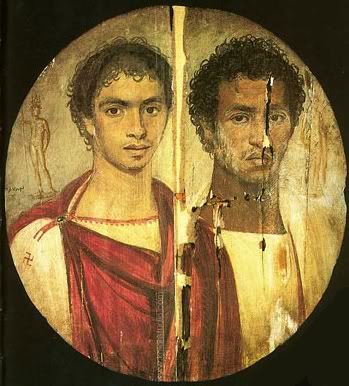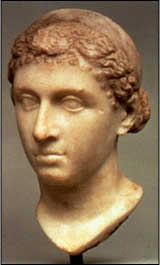I posted a picture of this person earlier in the thread. He's a roman-egyptian, not an ancient egyptian, so he's not a good depiction of what an ancient egyptian would have looked like. There's a good 2000 years in between the ancient egyptians and roman-egyptians (roughly). What's more important is he's Tiger Woods.
I didn't know that he was part Roman - sorry, I would not have used the picture if I knew.
However, the fact that an "Egyptian" who is late Classical period AND part Roman still looks considerably like the ancient statue, supports the idea that there was not a tremendous phenotypic gap between Romans (of the Classical period) and Egyptians (of both the dynastic and Classical periods). Just as, for instance, people who are multiethnic between White/Latino demonstrate that there is a pretty small gap between those two ethnicities.
BTW I see no reason to demean Classical Egyptians (in comparison to their ancestors) as Egypt was still a very cultured, if not so geopolitically powerful, civilization well into the Classical period. The ethnicity of the Classical Egyptians is just as relevant to the whole "who should be proud of Egypt" question as the ethnicity of the New Kingdom Egyptians.
Classical Egypt is still important to Egypt's heritage as a nation, just like Roman Britain.
The Ancient Egyptians themselves recorded their origins as being a place called Punt which was said to be South of Egypt (a claim consistent with Archeological, Linguistic and Cultural Evidence) and a place they actually traded with during Dynastic times by traveling South by boat through the Red Sea. Most modern scholars, based on the items they documented were taken from Punt point to the Horn of Africa as Punt's location.
There is some science brewing - that as an Egyptology fan I'm sure you're aware of - that the proto-Egyptians were actually influenced much more (culturally) by the Sahara than Ethiopia. iirc it's based on Sahara dig finds?
You are very enthusiastic about what you call the bio-anthropological evidence but as a reminder, neither language nor culture nor even heritage are determinative of appearance.
We're not really having a debate about where the Egyptians
came from because a) I mostly agree with you and b) it is irrelevant to the larger question. The Egyptians as indigenous Africans obviously have a heritage leading back to somewhere inside Africa. So do the Berbers.
We're having a debate about what the Egyptians
looked like and for that question, artwork of/by Egyptians, and Egyptian mummified bodies are the only direct evidence. The mummified bodies are mostly of royals who inbred considerably and had some really deformed features, like Tut's skull.
You said the Egyptians had "tropical body plans." Yeah - because body plans are considerably adaptive. Plot body plan versus longitude and see how much variation is left to attribute to heritage...
Humans can live all over the earth for a reason

The medium brown skintone they used for themselves is far darker than the average[...] modern Southern European and Southwest Asian such as Greeks, Italians, Palestinians or Arabs.
That's because modern Southern European and Mediterranean peoples are considerably lighter than their ancestors of the Classical period, for reasons that shouldn't be too hard to guess.
That said, yes the classical Egyptian was on average browner than his Roman counterpart, as the art confirms.
Also, I disagree with a few of the ethnicities you chose to compare to. Modern "Greeks" are actually considerably Turkish. Arabs are not Mediterraneans (South Europeans) but rather Semites like the Hebrews and Akkadians.
Do you see a difference in morphology?
Yes. First of all the Egyptian bust is considerably more stylized. However there are some morphological differences that are distinguishable. The Egyptian's eyes are almond shaped, his lips are fuller than the Roman's, and his nose is wider than the Roman's and is straight as compared to the Roman's slightly aquiline nose (difficult to tell from this angle).
Their cheekbones and jaw structure are about the same.
Which man above has a complexion closer to the skin color the Ancient Egyptians used for themselves?
The Oromo man for sure, but that's not a very fair comparison. The "Italian" you picked has some pretty obvious non-Mediterranean heritage - as do many Italians and French people. I have been to Italy and one thing that surprised me is that Italians vary significantly in skin color from quite pale to quite dark brown.
This man is a bit closer to the average of what I saw in Italy:
although, again, I saw many Italians both lighter and darker than this.
I would say that
the color the Egyptians picked to ethnically stereotype themselves is somewhere in between that man and the East African (Oromo) man.
However, keep in mind the color White people picked to ethnically stereotype ourselves is peach. How many "peach-colored" white people do you know?
By pointing to the artwork, I'm just saying the Egyptians were in the neighborhood of clay-brown, as opposed to the neighborhoods of pale Asiatic and black Nilotic.









 :shakehands:
:shakehands:




